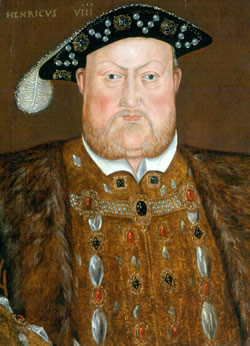Henry VIII
1491- 1547
Title.

Henry VIII was born at Greenwich on the 28th of June 1491, the second son of Henry VII and Elizabeth of York. He became heir to the throne on the death of his eldar brother, Prince Arthur, in 1502 and succeeded in 1509.
In his youth he was very intelligent and athletic. Henry's scholary interests included writing boh books and music and he was lavish patron of the arts. He was a composer and a accomplish playr of many instruments and a composer. Greensleeves, the popular melody frequently attributed him is, however, almost certaintly not one of his compositions.
Shortly after Henry's father died he married Katherine of Aragon. Henry increasingly relied on Thomas Wolsey to rule for him and Wolsey became lord chancellor in 1515. One of Henry's favourite pursuits, alongside hunting and dancing, was to wage war. Thomas Wolsey organised the first French campaign and proved to be an outstanding minister. The Scots were defeated at Flodden in 1513. But war with France ultimately proved expensive and unsuccessful and Wolsey's ascendancy was cut short by Henry's need for a male heir. He was determined to replace Catherine - whose only surviving child was a daughter, Mary, but the pope refused to grant the divorce. In 1533, Henry went ahead anyway and married Anne Boleyn, with whom he had a daughter, Elizabeth. The pope excommunicated him, and parliamentary legislation confirmed Henry's decision to break with Rome. With the help of Wolsey's replacement, Thomas Cromwell, Henry established himself as head of the Church of England and ordered the dissolution of the monasteries. Other reforms - including the uniting of England and Wales and the creation of the Council of the North and the Household and Exchequer - were also instigated during the 1530s. Henry grew tired of Anne Boleyn, who had failed to produce a male heir, and she was executed for adultery and treason in 1536. Jane Seymour became queen and in 1537 produced a male heir, Edward, but died after childbirth.Henry's personal religious beliefs remained Catholic, despite the growing number of people at court and in the nation who had adopted Protestantism. In an attempt to establish a Protestant alliance with German princes, Cromwell arranged a marriage between the king and Anne of Cleves. Henry divorced her a few months later and turned on Cromwell, who was executed. The final years of his reign witnessed his physical decline and an increasing desperation to appear all-powerful. In 1540, he married Catharine Howard but she was executed for adultery and treason within two years. A final marriage to Catherine Parr was more harmonious. There were fruitless and expensive wars against Scotland and France. Henry died on 28 January 1547 and was succeeded by his son, Edward.
In his youth he was very intelligent and athletic. Henry's scholary interests included writing boh books and music and he was lavish patron of the arts. He was a composer and a accomplish playr of many instruments and a composer. Greensleeves, the popular melody frequently attributed him is, however, almost certaintly not one of his compositions.
Shortly after Henry's father died he married Katherine of Aragon. Henry increasingly relied on Thomas Wolsey to rule for him and Wolsey became lord chancellor in 1515. One of Henry's favourite pursuits, alongside hunting and dancing, was to wage war. Thomas Wolsey organised the first French campaign and proved to be an outstanding minister. The Scots were defeated at Flodden in 1513. But war with France ultimately proved expensive and unsuccessful and Wolsey's ascendancy was cut short by Henry's need for a male heir. He was determined to replace Catherine - whose only surviving child was a daughter, Mary, but the pope refused to grant the divorce. In 1533, Henry went ahead anyway and married Anne Boleyn, with whom he had a daughter, Elizabeth. The pope excommunicated him, and parliamentary legislation confirmed Henry's decision to break with Rome. With the help of Wolsey's replacement, Thomas Cromwell, Henry established himself as head of the Church of England and ordered the dissolution of the monasteries. Other reforms - including the uniting of England and Wales and the creation of the Council of the North and the Household and Exchequer - were also instigated during the 1530s. Henry grew tired of Anne Boleyn, who had failed to produce a male heir, and she was executed for adultery and treason in 1536. Jane Seymour became queen and in 1537 produced a male heir, Edward, but died after childbirth.Henry's personal religious beliefs remained Catholic, despite the growing number of people at court and in the nation who had adopted Protestantism. In an attempt to establish a Protestant alliance with German princes, Cromwell arranged a marriage between the king and Anne of Cleves. Henry divorced her a few months later and turned on Cromwell, who was executed. The final years of his reign witnessed his physical decline and an increasing desperation to appear all-powerful. In 1540, he married Catharine Howard but she was executed for adultery and treason within two years. A final marriage to Catherine Parr was more harmonious. There were fruitless and expensive wars against Scotland and France. Henry died on 28 January 1547 and was succeeded by his son, Edward.
